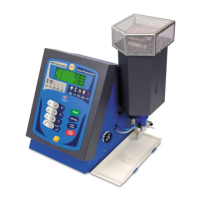Operational recommendations
The Flame Photometer must be installed in a clean, draught-free
environment, where a stable temperature can be maintained.
The instrument should also be sited away from bright sunlight
and other intense light sources, (away from doors, windows, fans
A/C units, etc.). The atmosphere must be free of airborne
contaminants such as cigarette smoke, vapour, dust and solvents.
Failure to observe these precautions may lead to inaccurate
and/or unstable results.
Ensure there is a clear drain to waste. Check that the drain tubing
is free from kinks and that the end is kept above the level in the
waste container (if used). The T-piece supplied should be fitted to
avoid any possibility of a partial syphon being formed.
NOTE: An air lock preventing drainage will occur if the waste tube
falls below the water level in a waste bucket or waste receptacle.
Always use the same batch of diluent. It is recommended that
diluent concentrate (019-015) is added to all standards and
samples at a ratio of 1:100.
Users should ensure they have access to adequate quantities of
deionised (019-051) or distilled water. It is important to ensure
the quality and purity of the water is consistent and appropriate
to the types of samples being analysed.
For optimum performance and accuracy always use the same
techniques and apparatus when performing calibrations and
taking readings.
The samples should not be highly viscous or non-homogeneous.
If possible, samples likely to contain sediment should first be
filtered.
Avoid handling samples, or touching any item in contact with
samples, with unprotected fingers. Doing so could lead to serious
contamination and significantly impair the accuracy of results.
Solutions should always be stored away from direct sunlight,
and preferably at temperatures below 25˚C. Glass containers
should not be used for storage as these may lead to
contamination through sodium leaching into the solution.
Standards should be prepared and stored in plastic vessels,
in high concentrations (i.e. 1000ppm or greater). Dilutions
should be prepared as required and discarded at the end of
each working day.
The flame photometer must be allowed to fully warm-up
prior to calibration and sample analysis. After the flame has
been lit, aspirate diluent or deionised water for a minimum
of 45 minutes prior to use. A warm-up period of more than
an hour will ensure the accuracy and consistency of results
are maximised.
After ‘ignition slow start’, open the inspection flap to visually
check, and if necessary, optimise flame height. The inner
cone should be 10-12mm above the top of the burner.
Adjust by SLOWLY turning the Fuel control as required. Do
not re-adjust the flame height after calibration. Once
completed, close the inspection flap to avoid stray light
entering the optical system.
Samples should always be drawn from the top half of the
sample cup to avoid sediment or particulate matter being
drawn into the aspiration tube. Do not allow the sample cup
to become fully drained and never allow the aspiration tube
to draw dust or debris from the surface of the sample tray.
It is essential that the Nebuliser, Mixing Chamber and Burner
are maintained in a clean condition to avoid contamination
and analysis inaccuracies in the future. Always aspirate
deionised water for at least ten minutes after all samples have
been analysed, prior to shut down. If high salt content samples
have been analysed or contamination is suspected, extend the
period over which deionised water is aspirated.
7

